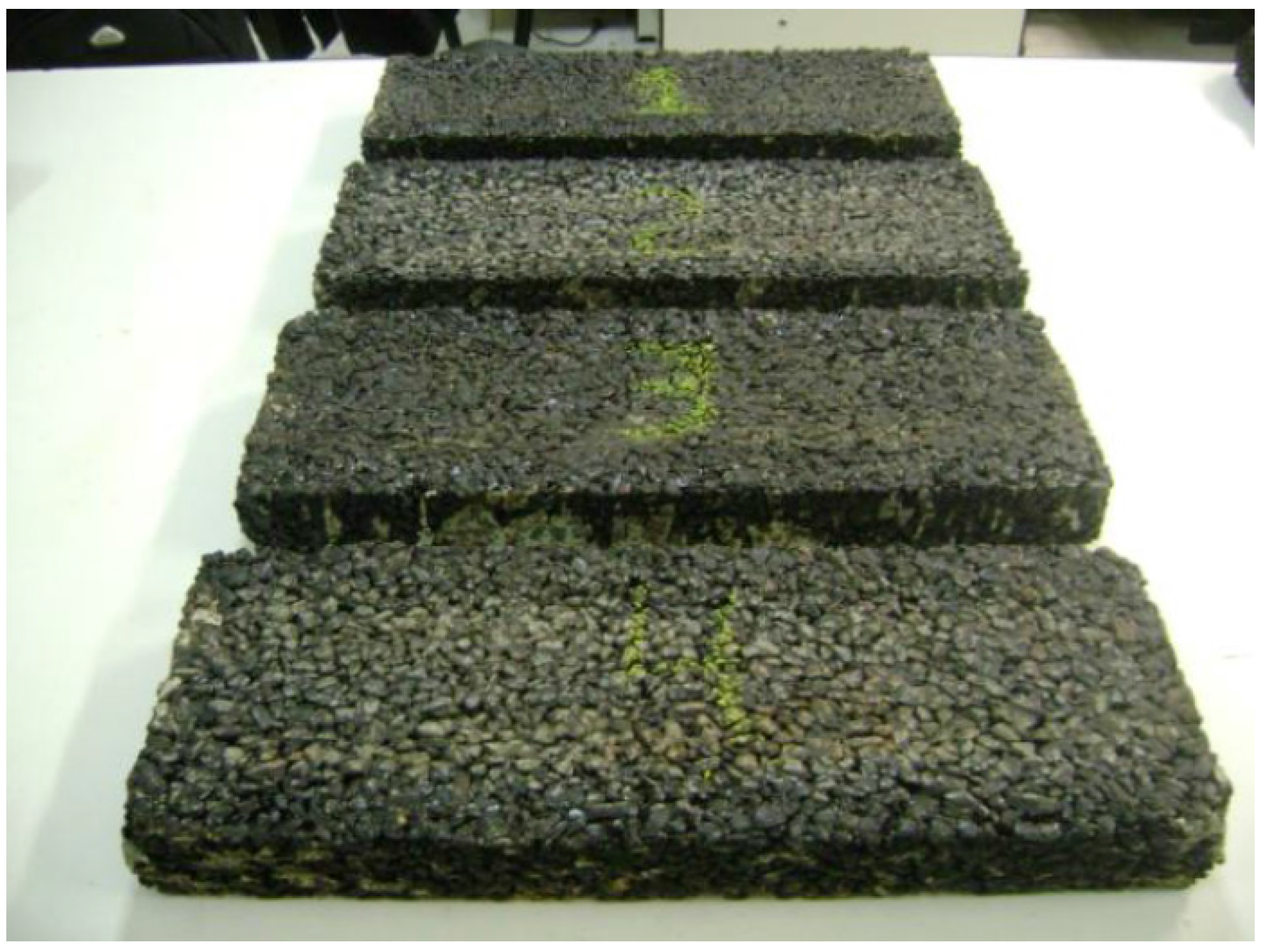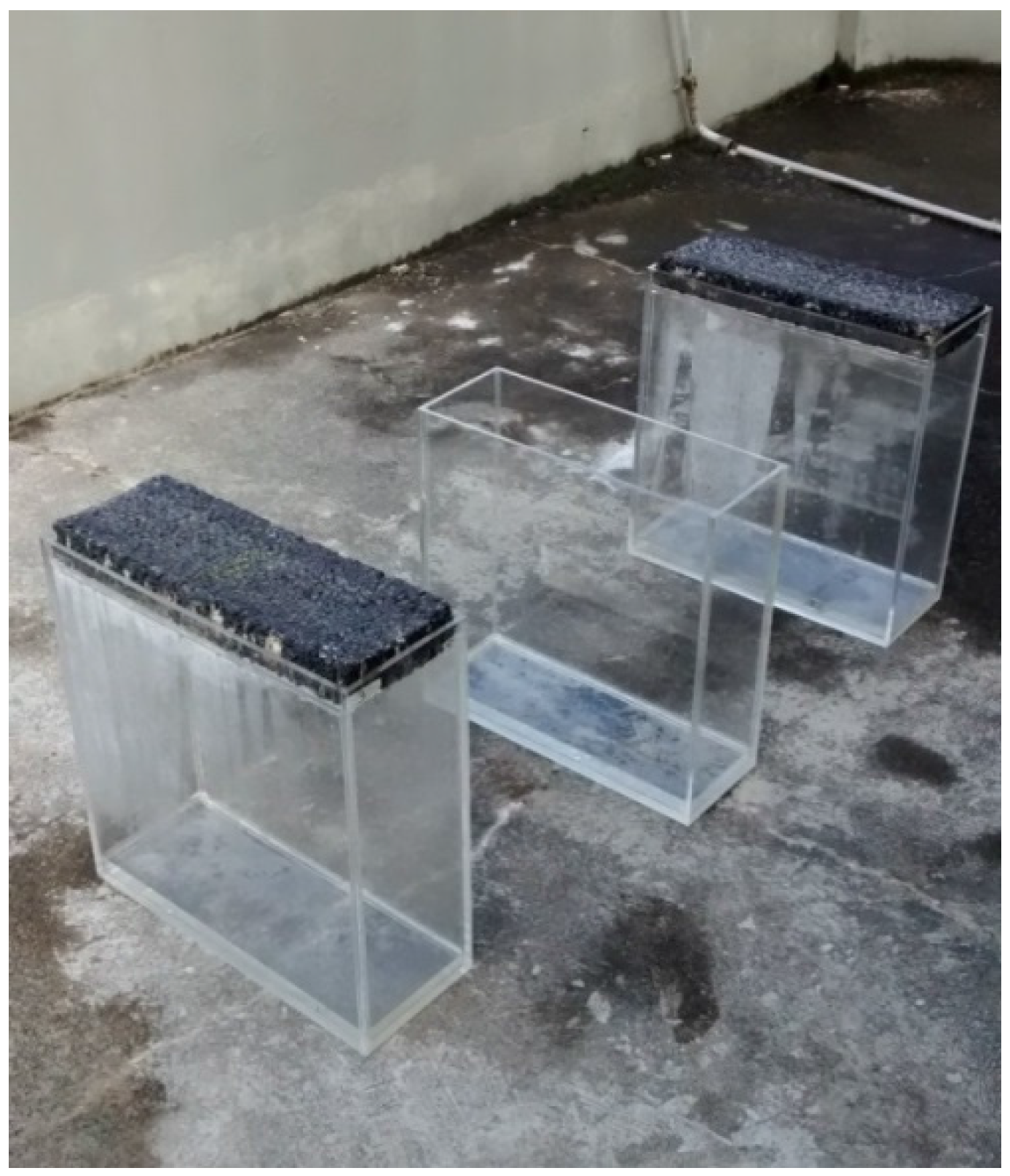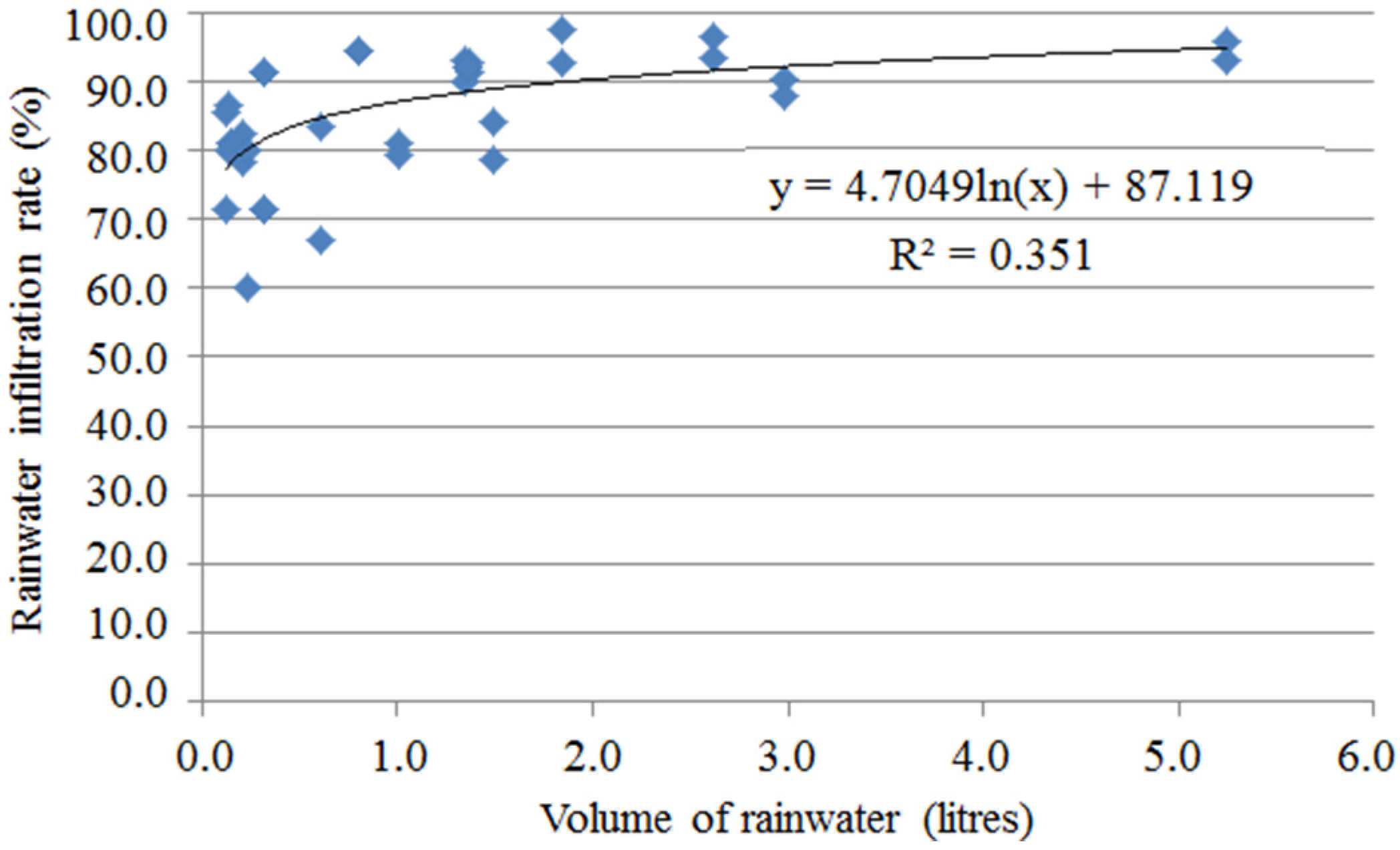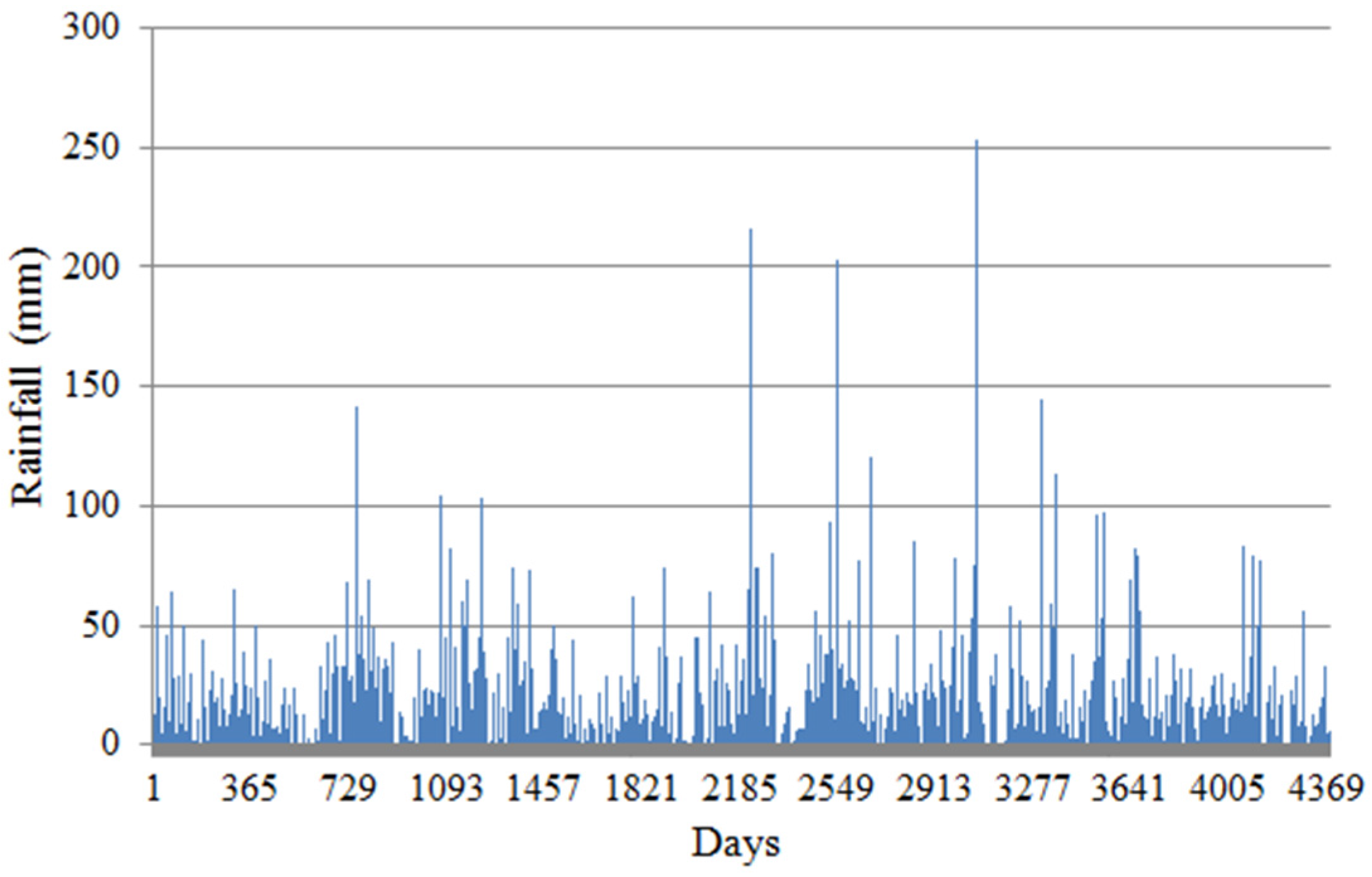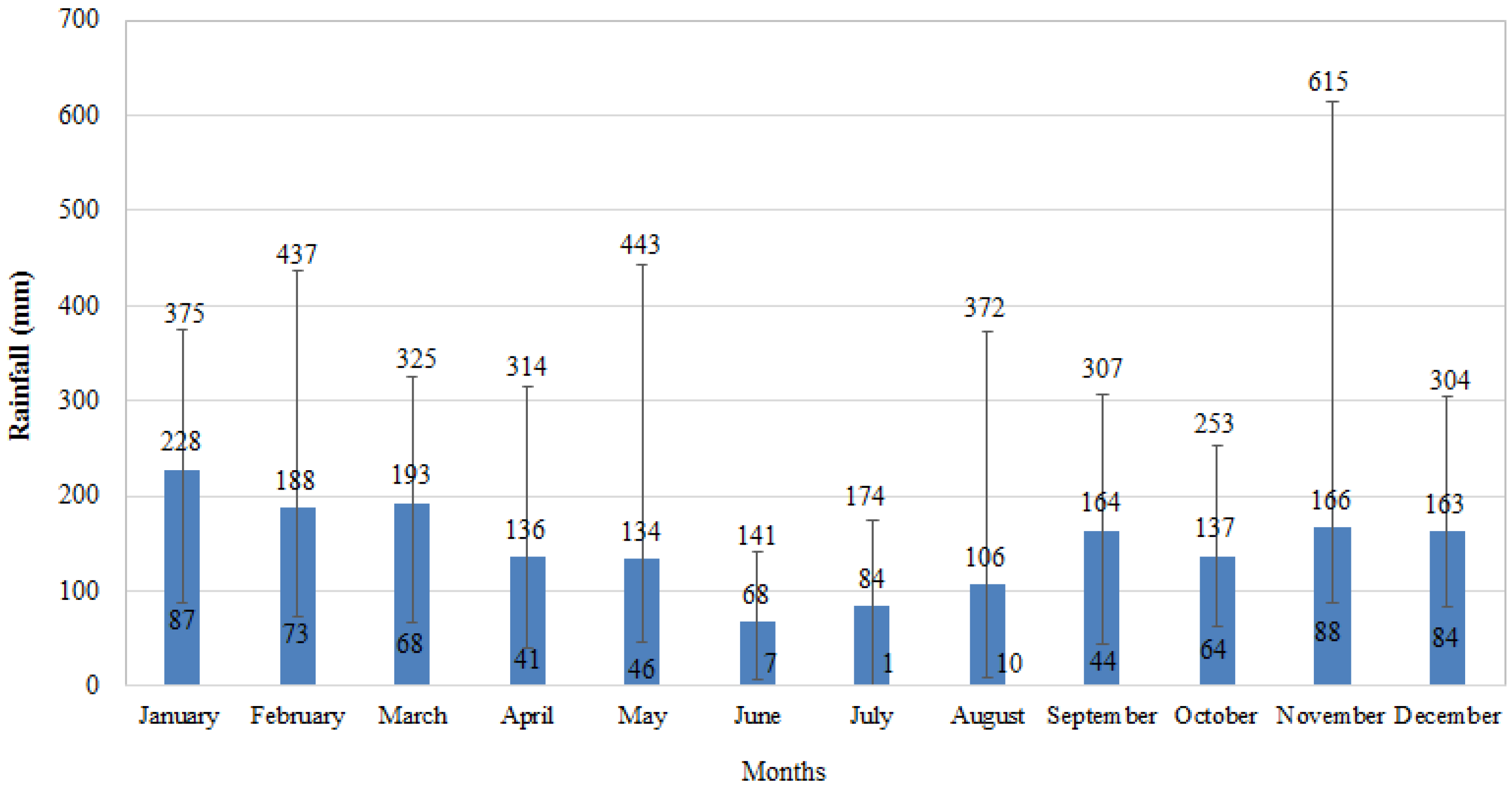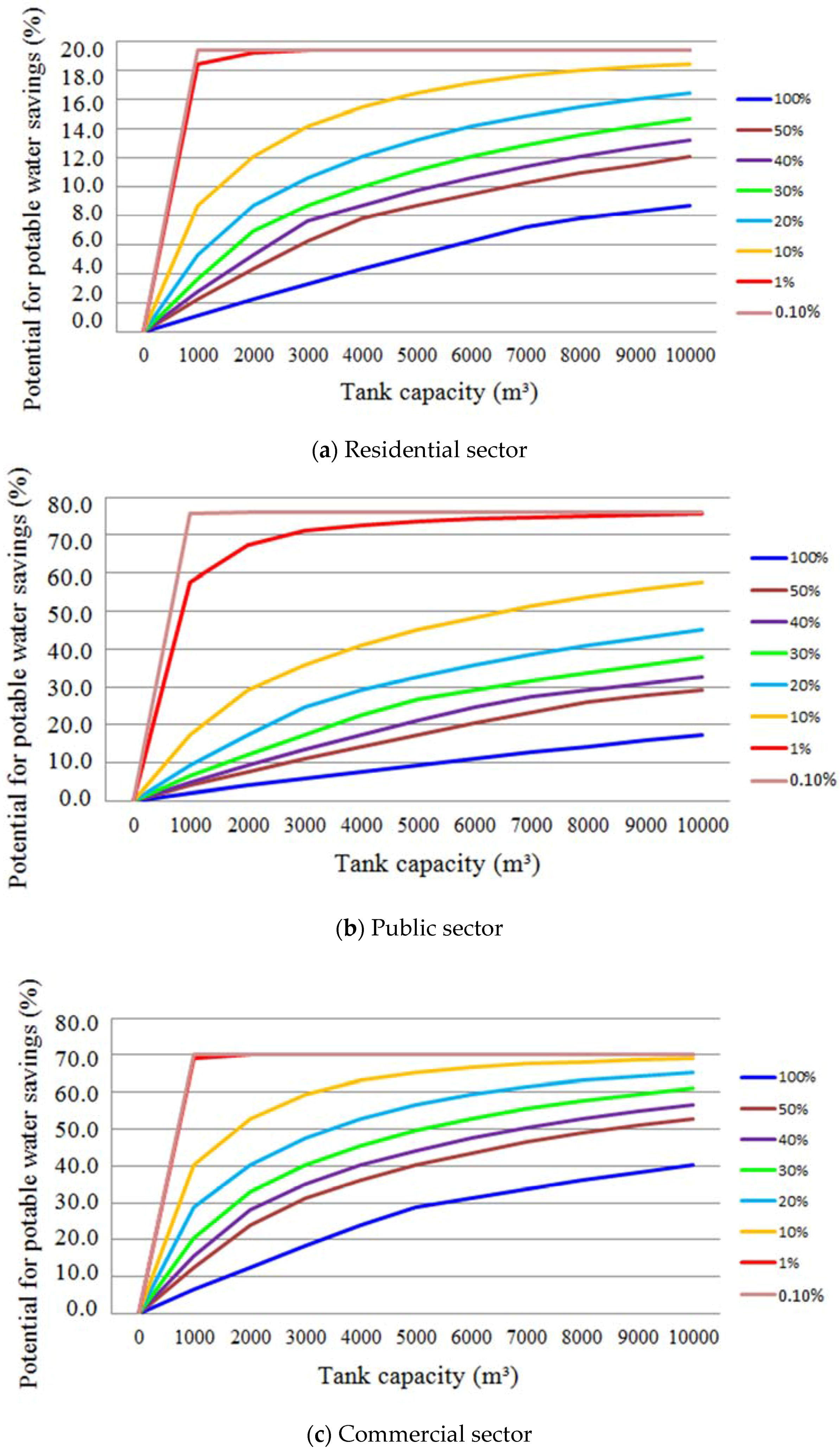1. Introduction
Due to increasing population and changing climate, water supply systems are under stress in many cities all over the world. Therefore, several measures such as demand management and alternative water sources have been adopted [
1].
Rainwater is a resource that has been studied and has shown great potential for potable water savings [
2,
3,
4]. Rainwater can be used for toilet flushing, garden watering, as well as washing clothes, sidewalks, and cars. Thus, it is possible to reduce the consumption of potable water, minimize flooding [
5] and water shortages together with preserving the environment by reducing the scarcity of water resources.
Water shortages are a problem in many countries [
6,
7]. According to Khastagir and Jayasuriya [
8], in Melbourne, Australia, the use of rainwater for domestic purposes has become increasingly popular since the city faced severe drought for twelve consecutive years, with annual rainfall below average. In the state of Victoria, the use of rainwater is relatively common, especially in rural areas, where 13% of families use it in domestic activities.
Despite having water availability around 33,000 m
3 per capita per year (a rate considered very high by the United Nations Environment Programme (UNEP)) [
9], Brazil can also suffer from water shortages due to poor distribution of population in relation to water resources. The Southeast and Northeast regions have less than 5000 m
3 per capita per year (considered low by UNEP). Estimates show that by 2100 these regions will have water availability lower than 1000 m
3 per capita per year (catastrophically low). However, there is a great potential for potable water savings by using rainwater in Brazil [
10].
Many studies available in the literature have been performed to estimate the potential for potable water savings by using rainwater in buildings [
1,
11,
12] to quote just a few). In Brazil, Ghisi
et al. [
13] analysed the residential sector of 62 cities and obtained potential for potable water savings ranging from 34% to 92%. Marinoski [
14] found potential for potable water savings that could be achieved through the implementation of a rainwater utilization system for non-potable uses in an educational institution in Florianópolis; the potential for potable water savings was 45.8%.
However, most of the articles found in the literature, as in the cases mentioned above, deal with the use of rainwater harvested from roofs of buildings [
15,
16,
17,
18] amongst many others). Few articles address stormwater collected from public roads and/or the assessment of its quality, which can be an important resource against water scarcity [
19,
20,
21,
22,
23] to quote just a few).
The number of roads built in cities is growing rapidly due to the fast urbanization. The surfaces of these highways are, in most cases, of low permeability, which increases the area of impervious surfaces. Thus, water cycle and stormwater quality are affected. Runoff of urban roads is considered to be one of the main sources of environmental pollution. Quality of runoff depends on many factors such as the type of surface, air quality, and anthropogenic local actions such as vehicle traffic density. Without proper treatment, pollutants found in the runoff, such as organic pollutants, copper, lead, zinc, and other heavy metals, are of concern because of their harmful effects. However, studies about the quality of water collected from the runoff of roads and control of pollutants could provide safer and more reliable basis for the use of stormwater in the future. Certain practices are used in order to decrease the volume of runoff in urban roads. Examples include infiltration systems, storage systems, and alternative road structure (porous pavements, for example). However, some of these practices reduce runoff but are inefficient for the removal of pollutants [
20].
Different types and specifications of pavements that can filter stormwater and also reduce freeway noise are already widely used in developed countries [
24,
25,
26]. However, in some cases, the investment made in these types of pavements aims at increasing road safety by decreasing the number of accidents caused due to the excess of water on the roads.
According to Scholz and Grabowiecki [
27], the runoff management in urban areas has been seen in a more ecological way due to the appearance of sustainable drainage systems that collect, store, process, and redistribute or recycle water. Compared to the traditional drainage, the stormwater infiltration process and the system retention are sustainable and suitable for urban areas. In addition, these systems have benefits such as reducing runoff, groundwater recharge, as well as water savings by recycling and pollution prevention.
Conventional flexible pavement is usually applied in public roads of most cities. In this type of pavement, the surface layer is, in general, impermeable. However, porous pavements could be used to collect stormwater from the pavement surface in order to minimize effects such as aquaplaning and hydroplaning. Thus, the permeable layer in porous pavements can be located on the pavement surface or underneath, depending on the layer chosen to collect the stormwater. Also, the pavement surface (asphalt concrete) can be produced using conventional asphalt or asphalt modified (SBS polymer—styrene-butadiene-styrene, asphalt rubber, SBR—styrene-butadiene-rubber, EVA—ethyl-vinyl-acetate, or other polymers).
However, stormwater collected from paved roads may contain high amounts of pollutants [
28]. Roads can be considered sources of various pollutants (suspended solids, heavy metals, hydrocarbons). These are found in the runoff and can contribute to contamination of water, and this contamination can be significantly reduced by using porous pavements. Consequently, the use of these pavements has grown in recent years. According to Pagotto
et al. [
29], the quality of stormwater is improved with the use of porous pavements with respect to most of the pollutants. Heavy metals are reduced by up to 74%, solids are retained at the rate of 87% and hydrocarbons are intercepted at an even higher rate (90%). Significant removal of pollutants has also been reported by Huang
et al. [
30].
Brattebo and Booth [
23] assessed the long-term efficacy of four systems of porous pavements in the United States. The systems were evaluated for six years of daily use. The study showed significantly better performance for porous pavements, both for the quality of water, which had lower toxic levels, and stormwater infiltration. Almost all precipitation infiltrated through all four systems. Copper and zinc levels obtained in the water samples collected from the runoff of the conventional asphalt concrete were worrying: toxic concentrations were found in 97% of samples. However, concentrations were below the detectable toxic level in 31 out of 36 water samples infiltrated in porous pavements.
Even with all the difficulty in removing water pollutants from runoff of roads, it is possible to improve the quality of such water by using porous pavements or other forms of stormwater treatment. These treatments are considered to be essential knowledge when it is desired to obtain an acceptable quality and when the pavement filter alone is not enough.
Removal of pollutants contained in stormwater runoff not only enables the reuse of such water for uses that do not require potable water (and that do not require strict quality standard) but also eliminates one of the sources of pollution of rivers, streams, and reservoir groundwater.
There is a wide range of articles in the literature showing the benefits of using porous pavements as well as the quality of water filtrated by this type of pavement [
23,
29,
31]. However, a great scarcity of research related specifically to the use of stormwater harvested from roads is apparent. Therefore, this paper aims to contribute to the assessment of the potential for potable water savings in buildings by using stormwater harvested from porous pavements.
3. Methodology
This work consists of a case study in the city of Florianópolis. It was intended to evaluate the potential for potable water savings in buildings from different sectors—residential, commercial, and public—by using stormwater from porous pavements. Models were constructed in order to assess infiltration and rainwater quality. Draining asphalt concrete slabs with two types of modifiers were used. Samples of stormwater from a local road were collected to evaluate water quality. Then, computer simulation using the Netuno computer programme was performed to assess the potential for potable water savings and rainwater tank sizing. Rainwater was considered for non-potable uses such as flushing toilets and urinals, cleaning external areas, and garden watering.
3.1. Infiltration through Asphalt Concrete Slabs
In this study, the draining asphalt concrete was tested considering only the asphalt concrete surface of porous pavements.
Four slabs of draining asphalt concrete with different modifiers were exposed to rainfall events in order to assess the rainwater volume infiltrated through the slabs. The goal was to simulate a real situation, in which the draining asphalt concrete slabs exert the function of asphalt concrete of highways and roads.
Figure 1 shows the slabs used in the study and
Table 1 shows the numbering of the slabs and their modifiers.
Porous asphalt mixtures have a high air void and for this reason they are more susceptible to desegregation in comparison to dense mixtures. In order to evaluate the resistance to desegregation, the porous mixtures were subjected to a cycling process in water. Thus, some mixtures were tested with water cycling and some without cycling. The cycling process in water involves subjecting the slabs to three alternating cycles of immersion in a water tank and drying in an oven, with each cycle lasting for 16 h (immersion in water for 8 h and then drying in an oven at 40 °C for 8 h).
Three acrylic boxes of the same size were used. Two of these were used to support the draining asphalt concrete slabs and store rainwater infiltrated through the slabs. The boxes were designed for the slabs to have a slope of approximately 2.5%, to represent highway and road slope. A third box was used in order to measure the total volume of rainwater for each rainfall event.
The three boxes were exposed simultaneously on the roof of the Department of Civil Engineering, Federal University of Santa Catarina, in Florianópolis, as shown in
Figure 2. From 14 February 2014 until 14 April 2014 samples were collected from 18 rainfall events. Thus, there were 18 samples of total rainwater volume and nine samples of infiltrated rainwater for each slab.
During the exposure of boxes and slabs of draining asphalt concrete to the rain, the height of rainwater stored in the box after each rainfall event was recorded. Thus, the infiltration for each slab was obtained using Equation (1):
where:
I is the rainwater infiltration in the draining asphalt concrete slab for each rainfall event (%);
h1 is the height of water stored in the box that holds the slab (mm);
h2 is the height of water stored in the box with no slab (mm).
In order to compare the results obtained from the four slabs, data were assessed for normal distribution as a prerequisite for comparing multiple averages. Then, the comparison of multiple averages was performed by using the Dunnet test. Each average was taken as a reference and the other three were compared to the reference.
3.2. Water Quality
The analysis of rainwater quality was divided into three stages: before contact with the asphalt draining concrete slabs, after rainwater infiltration through the slabs and, finally, the quality of stormwater samples collected directly from the runoff of a road was also evaluated. The parameters analysed were aluminium, ammonia, copper, chromium, iron, phosphorus, nitrite, dissolved oxygen, pH, and zinc. The analyses of such parameters were performed according to the guidelines of the chemical reagents supplier (Alfakit). A photocolorimetre AT 10P was used, except for the analyses that needed colorimetric comparison. This instrument has a resolution of 0.01 mg/L, margin of error of 3%, and relative precision of 2%.
3.3. Potential for Potable Water Savings
In order to determine the potential for potable water savings in buildings by using stormwater from roads, it was considered that rainwater would be used for non-potable uses such as flushing toilets and urinals, cleaning external areas, and garden watering. It was also considered that the volume of stormwater collected from roads is stored in one or more water tanks. The
Netuno computer programme, version 4, was used for the assessment of potential for potable water savings for different tank capacities [
32]. The programme was validated by Rocha [
33].
Input data for the computer simulations are: daily rainfall, surface area of paved roads, daily average potable water demand, rainwater demand (as a percentage of potable water demand), and runoff coefficient. Simulations for different tank capacities were run. In this study, the maximum tank capacity assessed was 10,000 m3, and the interval between each capacity was 1000 m3.
The simulations were performed separately for the three sectors: residential, public, and commercial. This separation is mainly due to large differences in water consumption and end-uses in buildings in these sectors. Thus, the simulation carried out individually represents a potential for potable water savings closer to the reality of each sector. Additionally, the potential savings were simulated for different paved areas in order to obtain tanks with smaller storage capacities. For each area, the potable water demand was divided accordingly. Simulations were performed for paved areas equal to 100%, 50%, 40%, 30%, 20%, 10%, 1%, and 0.1% of the total surface area of paved roads in Florianópolis.
Data on water consumption and end-uses in Florianópolis were obtained from different sources, such as SNIS [
34], Proença
et al. [
35], and Marinoski
et al. [
36]. Rainfall data were obtained from HidroWeb site—Hydrological Information Systems, National Water Agency. Thus, daily rainfall over a period of 12 years (1 January 2002 to 31 December 2013) was used in the simulations.
The total surface area of paved roads located in Florianópolis was obtained through a file issued by the Department of Public Works of Florianópolis. For the computer simulations, conventional pavement (impermeable) used in roads in Florianópolis was considered as porous pavement.
Asphalt mixtures used in porous pavements are not typically considered a structural component of a pavement. The durability of a porous mixture is different from traditional hot mix asphalt because the interconnected permeable voids not only allow water to drain, but also allow air to flow through the entire structure, rather than only the top surface. Over time, oxygen reacts with the binder and accelerates the aging, making the binder more brittle. Other characteristics which should be considered are durability issues, winter maintenance, and clogging of the surface voids [
37]. In the computer simulations performed herein, low level of surface distress was considered,
i.e., the water collected over the surface of the paved area was infiltrated through the pavement structure.
The runoff coefficient was calculated considering the rainwater infiltration through the asphalt concrete slabs and by decreasing a discharge coefficient obtained from studies in the literature, such as Deletic [
38] and Kayhanian
et al. [
39].
In a study conducted in the city of Lund, Sweden, Deletic [
38] noted that the first 20% of runoff contained 30.8% of the total suspended solids. This cannot be disregarded when use of stormwater collected from roads is desired. According to Kayhanian
et al. [
39] there are higher amounts of several pollutants at the beginning of a rainfall. Organic materials dissolved, organic carbon, nitrogen, copper, nickel, and zinc are some examples. Therefore, for this study, a discharge coefficient of 0.20 was used.
Thus, the coefficient of utilization of rainwater was calculated using Equation 2:
where:
Cu is the coefficient of utilization of rainwater (dimensionless);
Ia is the average rainwater infiltration in the draining asphalt concrete slabs (%);
Cd is the discharge coefficient, which was considered as 0.20 in this study (dimensionless).
4. Results and Discussion
This section presents the results for infiltration, water quality, water consumption data in Florianópolis, sizes, quantity and capacity of tanks to be used, and lastly the potential for potable water savings in buildings by using stormwater from porous pavements.
4.1. Infiltration through Asphalt Concrete Slabs
Table 2 and
Table 3 show all the quantitative data collected during the experiments. The total volume of rain in each event, the amount of rain infiltrated through the slabs, and the percentage of loss for each slab are shown. In addition, average, standard deviation, maximum and minimum infiltration for each slab are also shown.
From the statistical analysis, it was determined that the rainwater infiltration has a normal distribution with 95% confidence (p > 0.15 for each slab). Therefore, the Dunnet test was performed. p-value ranged from 0.976‒0.988 when slab 1 was taken as a reference; 0.875‒1.000 when slab 2 was taken as a reference; 0.909‒1.000 when slab 3 was taken as a reference; and 0.875‒0.985 when slab 4 was taken as a reference. Thus, averages were significantly similar to each reference value with 95% confidence. The confidence level for each single comparison was 98.1%. Therefore, the rainwater infiltration for draining asphalt concrete slabs was taken as the arithmetic average of the four slabs, i.e., 85.4%.
It is evident that there is no significant difference between rainwater infiltration for the slabs modified with asphalt-rubber (average 85.0%) and the slabs modified with SBS polymer (average 85.8%). There is also no significant difference between the slabs without water cycling (average 85.2%) and slabs with water cycling (85.6%). It is noticeable that the modification used in draining asphalt concrete does not influence the rainwater infiltration. From
Figure 3, it can be seen that, although the coefficient of determination is low, there is a trend in which rainwater infiltration through the slabs increases as rainwater volume also increases.
4.2. Water Quality
Table 4 shows the results for the quality of rainwater and
Table 5 shows a comparison between these results and others found in the literature.
As for the pH, it is noticeable that the results obtained in the study were very close to those found in Jaques [
40], who also evaluated rainwater quality in Florianópolis. Although the pH of water usually varies from 6.0 to 9.0, the results may be deemed normal. According to Jaques [
40], rainwater has become more acidic due to the presence of gases such as CO
2 and SO
2. This fact confirms that rainwater is not completely pure, having pollutants resulting mainly from burning fossil fuels in urban cities.
The concentration of dissolved oxygen was higher than that found by Annecchini [
41]. This parameter is rarely used when rainwater quality needs to be assessed. However, rainwater with low concentration of dissolved oxygen can influence the water quality of rivers, since the presence of dissolved oxygen is important for the survival of aquatic life.
The phosphorus concentration was lower than that found by Jaques [
40] in Florianópolis, but higher than the concentrations found by Annecchini [
41] and Rôdas and Steffen [
42]. This result indicates the important role of rainwater in removing pollutants from the atmosphere.
Regarding the presence of nitrite, the concentration found in this study was lower than the concentration found by Jaques [
40]. In the research conducted by Annecchini [
41], the values were always lower than 0.01 mg/L. Nitrite is an important parameter in the evaluation of water quality because its presence may indicate recent contamination by organic material.
The ammonia concentration observed in this study was lower than the value found by Hagemann [
43]. Potable water should not contain ammonia even in small quantities, since its presence indicates recent contamination by microorganisms or chemical agents. The result found (0.41 mg/L) indicates again that rainwater is not completely pure.
4.2.1. Rainwater Quality after Infiltration through Draining Asphalt Concrete Slabs
Table 6 shows the results on the evaluation of rainwater quality after infiltration through the draining asphalt concrete slabs. Ammonia and phosphorus concentrations in the modified slabs with addition of SBS polymer are considerably higher than in the modified slabs with addition of rubber. For other parameters—nitrite, dissolved oxygen and pH—no significant differences were observed. There was no significant difference found in the concentrations of parameters when the slabs without water cycling were compared with the slabs with water cycling.
Thus, the modifications used in the asphalt concrete slabs (addition of rubber and SBS polymer) can influence the quality of rainwater infiltrated through these slabs. On the other hand, water cycling does not interfere in the rainwater quality infiltrated through the slabs.
It could also be observed that, in most cases, phosphorus had a standard deviation higher than the average itself. This large variation can be explained mainly by a possible contamination existing in the slab, and the period of time between rainfall events. In the first experiment of each slab, a very high concentration of phosphorus was obtained. In the second event of rain, the concentration of phosphorus decreased, indicating that the rainwater possibly reduced the amount of contaminants present in the slabs. As for the time period between rainfall events, it is known that the longer the periods with no rainfall, the greater the pollution contained in the slabs.
Modifiers such as SBS and tire rubber can be used to increase the asphalt flow characteristics and improve the low-temperature flexibility and fatigue resistance. However, they are composed of different chemical constituents, such as ammonia and phosphorus. For instance, ammonium acetate gel foams are based on a blend of natural latex with styrene-butadiene latex. Also, phosphate is mainly used as flame retardant in plasticizers and engineering plastics as butadiene-styrene blends and polycarbonate. Rubber from waste tires contains latex and styrene-butadiene rubber in its composition [
44,
45,
46]. Manuel and Dierkes [
47] state that the use of polymers enhances the asphalt properties, but the use of latex should be limited due to problems of foaming, steaming, and emission of ammonia.
By comparing
Table 6 with
Table 4, it could be observed that there was an increase in the concentration of phosphorus in all slabs and a reduction of ammonia in the slabs produced with tire rubber. In relation to the concentration of phosphorus, the results may be explained considering that both tire rubber and SBS polymer contain this compound [
44,
45,
46]. As for ammonia, its concentration increased in the SBS slabs and decreased in the tire rubber slabs. This is due to the fact that the amount of ammonia in the SBS polymer is higher than in the tire rubber [
47]. In this study, the asphalt rubber slabs retained ammonia so that its concentration in the rainwater decreased.
4.2.2. Stormwater Quality of the Runoff of Roads
Table 7 shows results for the stormwater quality assessment, collected directly from the runoff of a road, through some selected parameters.
Table 8 shows a comparison of the results obtained in this study with results from other references. It is important to bear in mind that researches used as reference for comparisons were not made in the same public road that the current study was performed. Thus, important aspects such as the daily traffic of vehicles on the road and stormwater catchment area were different for each reference. Thus, the anthropogenic action that changes the water quality had different effects on each result. However, the data show the differences between roads and provide information on the stormwater runoff quality collected directly from public roads.
The aluminium concentration observed in the study was 0.23 mg/L. This result is greater than that found by Baeckstroem
et al. [
48] in Sweden, who obtained a concentration of 0.15 mg/L, but lower than the value found by Shinya
et al. [
49] in Japan (1.98 mg/L). Aluminium is mainly found in the solid form in stormwater collected from roads and its main sources are engine wear, leaks and other vehicle components.
Copper concentrations had also a large variation in the surveys used as reference, ranging from 0.0065 [
49] to 0.194 mg/L [
20]. The copper concentration observed in this study was 0.12 mg/L. Copper is also a component which is mainly found in dissolved form. Wear on the brakes, engine wear and leaks from vehicles are the main sources of copper detected in stormwater runoff from roads. Copper is found in greater quantities at the beginning of a rainfall and, therefore, the discharge of the first millimeters of stormwater helps to reduce the concentration of this pollutant. The reduction of copper concentration in stormwater collected from pavements can be achieved through the use of porous pavements or treatments, such as grassy ditches, biofilters, and detention basins. The reduction of copper may reach 95.2% [
20].
The chromium concentration obtained in the study was above the values found in the literature, yielding an average of 0.08 mg/L. Shinya
et al. [
49] found a chromium concentration of 0.00175 mg/L in their survey conducted in Japan. Baeckstroem
et al. [
48] obtained 0.00056 mg/L in Sweden, while Barbosa and Hvitved-Jacobsen [
50] did not detect the presence of chromium in their studies in Portugal. Detention basins and porous pavements allow the reduction of chromium concentration up to 66% [
51] and 88% [
52], respectively.
The average iron concentration obtained in this study was 1.41 mg/L. Shinya
et al. [
49] found an iron concentration of 3.715 mg/L in Japan, while Baeckstroem
et al. [
48] found a concentration of 0.334 mg/L in Sweden. Iron is also mainly found in the solid form in stormwater collected from roads. Its main source is vehicle components. The iron concentration in stormwater collected from roads can be reduced through the use of detention basins. The reduction may reach up to 74% [
51].
The phosphorus concentration in the stormwater collected directly from the public road runoff (2.11 mg/L) was much higher than the phosphorus concentration in the rainwater from the atmosphere (0.14 mg/L). This is mainly due to pollution found in stormwater runoff, whose source is vehicle traffic and other anthropogenic activities. In research by Gilbert and Clausen [
53], in the United States, the phosphorus concentration in stormwater collected in a highway was 0.244 mg/L, while Xue and Kang [
54] report that the phosphorus concentration may vary from 0.5 to 5.0 mg/L. Organic compounds are one of the main pollutants of stormwater collected from roads. The reduction in phosphorus concentration may be up to 78% [
55] using porous pavements or other treatments such as grass filter strips.
The pH of the stormwater collected from the public road runoff was more alkaline than the pH for the rainwater from the atmosphere. In this study, the pH of the rainwater from the atmosphere was 5.4, while the pH of the stormwater was 6.7. In the study by Helmereich
et al. [
56], the pH was 7.5 for a road located in Munich, Germany.
Regarding zinc, concentrations had a wide variation in the different surveys used as a comparison. The concentrations ranged from 0.0216 [
23] to 0.933 mg/L [
20], and we obtained an average of 0.13 mg/L. Metal components are the pollutants frequently found in runoff from roads. Among the heavy metals, zinc is considered one of the most abundant components. Zinc is found mainly in dissolved form in stormwater. This information is important to assist in developing effective strategies for the control of metals (in solid or dissolved form) in stormwater runoff. Zinc comes mainly from the wear of tires and other vehicle components and it is one of the parameters found in greater abundance at the beginning of a rainfall. Therefore, discarding the stormwater from the beginning of a rainfall event helps reduce the concentration of pollutant. Studies show that the use of porous pavements or other treatment for the stormwater collected from roads (grassy trench, biofilter,
etc.) can reduce the zinc concentration by 99.5% [
20].
As for ammonia, nitrite, and dissolved oxygen, little information was found regarding their concentrations in stormwater collected from pavements. However, comparing rainwater concentrations in the atmosphere with stormwater runoff, it follows that the ammonia concentration is higher in rainwater from the atmosphere (0.41 mg/L) than in stormwater runoff (0.11 mg/L). On the other hand, nitrite concentration is greater in stormwater runoff (0.02 mg/L) than in rainwater from the atmosphere (0.002 mg/L). For dissolved oxygen, there was no significant difference.
4.3. Water Consumption in Florianópolis
Water consumption and water end-uses for the residential, public, commercial and industrial sectors in Florianópolis are shown in
Table 9 and
Table 10, respectively. The residential sector has the highest consumption of water, followed by the public and commercial sectors, respectively. However, the public sector has the highest percentage of non-potable consumption, followed by the commercial and residential sectors, respectively.
4.4. Rainfall Data
Daily rainfall was used to determine the potential for potable water savings by using stormwater from paved roads in Florianópolis.
Figure 4 shows daily rainfall in Florianópolis during the years 2002 to 2013.
Figure 5 shows the average monthly rainfall for the same period, with maximum and minimum values for each month. The average annual rainfall over this period was 1766 mm.
4.5. Total Surface Area of Paved Roads in Florianópolis
From the map of roads in the city of Florianópolis, a total length of 1,577,745 m of paved roads was determined. Considering an average road width of 7 m, 11,044,216 m2 as the total surface area of paved roads was calculated. This area is only an estimate, since the roads have variable widths.
4.6. Rainwater Utilization Coefficient
As obtained from the Dunnet test, the infiltration figures were similar with 95% confidence. Therefore, the average rainwater infiltration for the four asphalt concrete slabs was 85.4%. Using Equation (2) it was possible to estimate the rainwater utilization coefficient. Thus, the rainwater utilization coefficient used in the simulations to calculate the potential for potable water saving was 0.654.
4.7. Potential for Potable Water Savings in Buildings
This section shows the potential for potable water savings in buildings by using stormwater from paved roads for different sectors in the city of Florianópolis: residential, public, and commercial.
Table 11 summarizes the percentage of areas used in the simulations, and also the value of paved roads area in m², and the corresponding water consumption for each sector.
Figure 6 shows the potential for potable water savings in buildings for different tank capacities and different percentages of paved road surface areas for the residential, public, and commercial sectors. It can be seen that the greater the tank capacity and the smaller the paved roads area, the greater the potential for potable water savings for the three sectors. For 0.1% of paved roads area and 1,000 m
3 tank capacity it is possible to obtain potable water savings of 19.4% in the residential sector, 75.7% in the public sector, and 70.0% in the commercial sector.
Table 12 summarizes the results. It shows rainwater demand, potential for potable water savings, tank capacity, and paved road surface area. For the three sectors, it is possible to obtain a potential for potable water savings similar to the rainwater demand (as a percentage of potable water demand). Stormwater collected from paved roads in Florianópolis could supply almost all the demand for non-potable water in residential, commercial, and public buildings. For each 11,044 m
2 of paved roads surface area, which is equivalent to approximately 1.6 km of paved roads length, it would be possible to supply almost all the rainwater demand with stormwater collected from paved roads using 1000 m
3 rainwater tanks.
This is a first study on the matter. Therefore, if this comes to be used in Florianópolis or any other place, attention should be given to sizing rainwater tank capacities in order to get smaller capacities, finding places to locate the tanks, distributing rainwater to buildings, and treating rainwater etc.
5. Conclusions
This work presented the first assessment on the utilization of stormwater collected from paved roads in Brazil. The treatment and the subsequent use of stormwater collected from roads for use in non-potable purposes could reduce the consumption of potable water, minimize water rationing, decrease the shortage of water resources, and in addition would control one of the main sources of the pollution of rivers and streams.
This study aimed to estimate the potential for potable water savings in buildings by using stormwater from porous-pavement roads. It was considered that the conventional asphalt concrete (impermeable) used in Florianópolis should be replaced with draining asphalt concrete, which has the function of infiltrating stormwater, thus avoiding phenomena such as hydroplaning.
Based on the water quality analysis, results indicated that rainwater from the atmosphere is not completely pure, containing certain pollutants. As for the rainwater quality after the infiltration through asphalt concrete slabs it was observed that the concentrations of ammonia and phosphorus are larger in the slabs modified with SBS polymer (0.65 and 0.74 mg/L, respectively). In the slabs modified with rubber, these concentrations were 0.21 and 0.43 mg/L. For the remaining parameters (nitrite, dissolved oxygen, and pH) there was no significant difference.
The quality of stormwater runoff from a public road with conventional pavement (impermeable) was also assessed. Aluminium, ammonia, copper, chromium, iron, phosphorous, nitrite, dissolved oxygen, and zinc average concentrations were 0.23, 0.11, 0.12, 0.08, 1.41, 2.11, 0.02, 9.0, and 0.13 mg/L, respectively. The pH value was 6.70. Results for the stormwater quality collected directly from a paved road were close to results obtained in the literature.
Knowing that is possible to treat stormwater collected from roads for later use in non-potable activities, it was possible to simulate the potential for potable water savings in buildings from different sectors—residential, commercial and public—by using stormwater from paved roads.
The city of Florianópolis has a surface area of paved roads approximately equal to 11,044,216 m² and average annual rainfall of 1766 mm over 2002–2013. For the residential sector, with a non-potable water demand of 19.4% of the potable water demand, the potential for potable water savings ranged from 1.2% to 19.4% depending on the tank capacity and paved road surface area. Such potential for potable water savings ranged from 2.1% to 75.7% in the public sector, and from 6.5% to 70.0% in the commercial sector.
These results confirm that the use of stormwater collected from paved roads for non-potable uses may be an important resource against water scarcity, as the availability of water resources is decreasing with increasing population and consequent increase of water demand.
